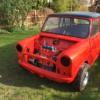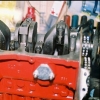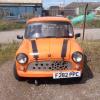
Piston Fitting
#1

Posted 18 December 2014 - 07:14 PM
#2

Posted 18 December 2014 - 07:15 PM
They're press fitted into the conrods on larger bore engines
#3

Posted 18 December 2014 - 07:26 PM
this is a 1000 cc engine though is it still the same?
#4

Posted 18 December 2014 - 07:28 PM
#5

Posted 18 December 2014 - 07:38 PM
and once its pressed in it just stays there?
#6

Posted 18 December 2014 - 07:54 PM
When I use press fit pins, I watch the pressure at I press them, off hand I can't recall the conversion (calculation) to 'tonnage' but anything less than 1100 on my gauge and I make the pins floaters in the rods and then fit buttons. Better safe than sorry. I know Teflon Buttons are popular (to keep the weight down) however I generally prefer aluminum ones.
I know the figure of 1100 won't necessarily mean much, but the point I was trying to make is that a 'press fit' on it's own can be risky without knowing that there's enough interference.
#7

Posted 18 December 2014 - 07:55 PM
#8

Posted 18 December 2014 - 08:51 PM
When I use press fit pins, I watch the pressure at I press them, off hand I can't recall the conversion (calculation) to 'tonnage' but anything less than 1100 on my gauge and I make the pins floaters in the rods and then fit buttons. Better safe than sorry. I know Teflon Buttons are popular (to keep the weight down) however I generally prefer aluminum ones.
I know the figure of 1100 won't necessarily mean much, but the point I was trying to make is that a 'press fit' on it's own can be risky without knowing that there's enough interference.
I may sound really stupid but please could you dumb that down for me a bit haha:) this bit is all new to me, also do you think I should use this type or others? will they be ok?
#9

Posted 18 December 2014 - 08:52 PM
#10

Posted 18 December 2014 - 09:14 PM
Or heat the small end evenly and slowly until it goes blue or burns off carbon deposits and the pin should slide striaght in, hold the pin and piston steady and swing the rod until it grips the pin then keep swinging the rod for about 15 seconds and make sure it's still nice and free in the piston once it's fully cooled and work lots of oil into the relief in the skirt for the pin for initial start up lubrication
good idea! this would be a lot better than a press for me because there is no one around where I am that could press it for me
#11

Posted 18 December 2014 - 09:30 PM
OP - this may be a daft question, but did the old pistons from your 998 engine have circlips?
You get some 998cc pistons with circlips (fully floating gudgeon pin), and others without (interference press-fit gudgeon pin).
Not advisable to mix these up, the connecting rods are different. If your connecting rods have a bronze bush in the small end then these are for the fully floating type gudgeon pins.
#12

Posted 18 December 2014 - 09:30 PM
#13

Posted 18 December 2014 - 09:33 PM
#14

Posted 18 December 2014 - 09:35 PM
Gee,,,, you know you've put your foot in it when,,,,,,
I may sound really stupid but please could you dumb that down for me a bit haha:) this bit is all new to me, also do you think I should use this type or others? will they be ok?
Haha, all good!
Being Press Fit Pins, it's likely you'll have your machine shop man do this for you as done the wrong way, you'll wish you never saw press fits. Still, it's nice to have an understanding of what goes on behind the Piston Ring Poster that's behind the counter,,,,,
OK, the Bore of the Little End will be a slightly smaller diameter than the the diameter of the Gudgeon Pin, this is what we call an Interference fit. Typically (on these engines at least) the interference should be 0.0008 (yes, 0.8 of 1 thousand) to 0.0015". It can be rather tricky to measure that exactly on the little end bore, none the less, it can be done. So, to fit them, I use a cradle that holds the small end of the Con Rod, over which the Piston can go and then Press the Pin. The Small end while measuring up OK, may have been previously overheated or poor spec material or even just fatigued (rare but does happen), so a rough (but honest!) way to check how tight the Small End is gripping the Pin is check the 'Tonnage' needed to press the Pin and check it all the way, the pin could be thinned in the centre or it could be dragging material off the Rod. I use a Molly Lube when doing this.
I'd say that the bush in the Little End (o the small bore Rods) would be pressed out before all this and the Pin pressed in to that bush's place.
Just as a side note, another Aust Production 'quirk' is that our locally made 998's all had Press Fit Gudgeons from the factory. OK, now back on track.
Now, I gotta say, I'm not crazy about Press Fit Pins, I've just seen too many problems from them, though I still do many engines with them, but anything that's going to be 'pushed' no way. Maybe I'm just being anal.
Anyways, if converting from a Press fit to a Floating Pin (similar to the Small Bore engines), I hone the Small Ends until I get 0.0005 to 0.0008" (0.5 to 0.8 of 1 thousand) clearance from the Pin to the Bore of the Small End. Then to stop the Pin burrowing it's way in to the Bore, I turn up 'Buttons, that are a loose press fit in to the ends of the Pins (be sure they have a vent hole that's off-set!). I don't actually have any photos of my own, but here's one I pinched from the web
Those are likely Teflon Buttons, while I do use these, I also fit Aluminum ones too, which are more reliable than the Teflon, not that I know of any issues with Teflon ones!
#15

Posted 18 December 2014 - 10:20 PM
Gee,,,, you know you've put your foot in it when,,,,,,
I may sound really stupid but please could you dumb that down for me a bit haha:) this bit is all new to me, also do you think I should use this type or others? will they be ok?
Haha, all good!
Being Press Fit Pins, it's likely you'll have your machine shop man do this for you as done the wrong way, you'll wish you never saw press fits. Still, it's nice to have an understanding of what goes on behind the Piston Ring Poster that's behind the counter,,,,,
OK, the Bore of the Little End will be a slightly smaller diameter than the the diameter of the Gudgeon Pin, this is what we call an Interference fit. Typically (on these engines at least) the interference should be 0.0008 (yes, 0.8 of 1 thousand) to 0.0015". It can be rather tricky to measure that exactly on the little end bore, none the less, it can be done. So, to fit them, I use a cradle that holds the small end of the Con Rod, over which the Piston can go and then Press the Pin. The Small end while measuring up OK, may have been previously overheated or poor spec material or even just fatigued (rare but does happen), so a rough (but honest!) way to check how tight the Small End is gripping the Pin is check the 'Tonnage' needed to press the Pin and check it all the way, the pin could be thinned in the centre or it could be dragging material off the Rod. I use a Molly Lube when doing this.
I'd say that the bush in the Little End (o the small bore Rods) would be pressed out before all this and the Pin pressed in to that bush's place.
Just as a side note, another Aust Production 'quirk' is that our locally made 998's all had Press Fit Gudgeons from the factory. OK, now back on track.
Now, I gotta say, I'm not crazy about Press Fit Pins, I've just seen too many problems from them, though I still do many engines with them, but anything that's going to be 'pushed' no way. Maybe I'm just being anal.
Anyways, if converting from a Press fit to a Floating Pin (similar to the Small Bore engines), I hone the Small Ends until I get 0.0005 to 0.0008" (0.5 to 0.8 of 1 thousand) clearance from the Pin to the Bore of the Small End. Then to stop the Pin burrowing it's way in to the Bore, I turn up 'Buttons, that are a loose press fit in to the ends of the Pins (be sure they have a vent hole that's off-set!). I don't actually have any photos of my own, but here's one I pinched from the web
Those are likely Teflon Buttons, while I do use these, I also fit Aluminum ones too, which are more reliable than the Teflon, not that I know of any issues with Teflon ones!
cheers for that :)
1 user(s) are reading this topic
0 members, 1 guests, 0 anonymous users



















